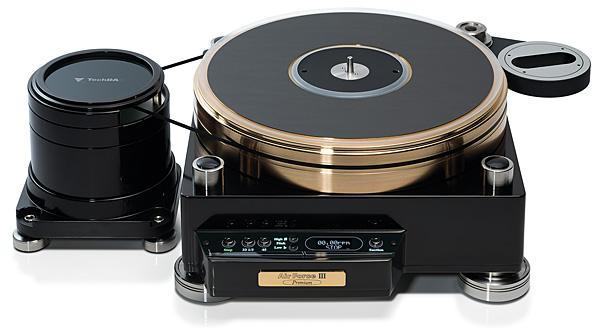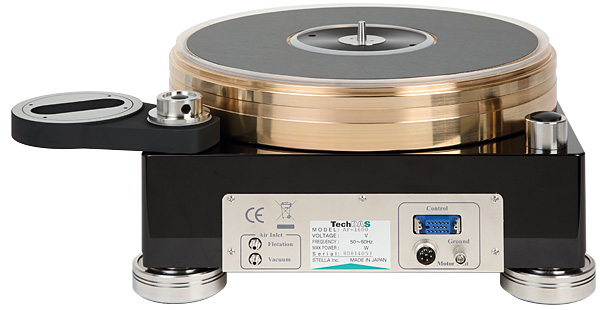TechDAS Air Force III Premium Turntable

 TechDAS' Air Force III gets the Premium treatment, with upgrades throughout the design, a heavier platter and revised 'Air Condenser' – does it punch above its weight?
TechDAS' Air Force III gets the Premium treatment, with upgrades throughout the design, a heavier platter and revised 'Air Condenser' – does it punch above its weight?
Positioned in the 'lower half' of the burgeoning TechDAS catalogue, the original Air Force III [HFN Sep '16] delivered more compact dimensions, the capability to handle up to four tonearms and a substantial saving over the One [HFN Jun '13] and Two [HFN Apr '15] turntables. Even with its new, performance-gap-closing fitments in Premium guise, the price is two quid shy of £29,000 – roughly a tenth the estimated cost of the forthcoming Air Force Zero flagship and £17,000 less than the Two Premium. A bargain, then?
Afraid so: as has been a common occurrence of late, this masterpiece smacks you upside the head with the Law of Diminishing Returns. Its performance is so good that, like the entry-level DS Audio DS-E1 cartridge [HFN May '19], it will assuage the pain of not being able to afford the more costly offerings.
Clear Voice
Fortunately for me, tasked with reviewing the III Premium, I have also used it at shows and have heard it played side-by-side with its dearer siblings. Because TechDAS knows how to voice its products, the hierarchy remains intact. What changes is the size of the gap between each level, which seems to grow ever narrower.
Because the pecking order remains whole, if you can afford the One or the Two, don't let me stop you. But each deck serves a different need beyond ultimate performance because the III, the III Premium and the even more compact Air Force V [HFN Jan '19] demand less shelf space and they outdo the One and Two in the maximum number of arms they can accommodate. So sound and price aren't the only determinants. [Note: the One and Two have their model numbers spelled out, while the III and V use Roman numerals.]
Offered in gloss black with gold accents and platter edge, to distinguish it visually from the 'III, the Premium edition is far more than an exercise in aesthetics. Most prominent among the improvements are a new PSU unit said by TechDAS to be 'almost equivalent to that of the Air Force One', with its air condenser also having double the capacity of the standard model. It is now fitted with two separate air pumps for air bearing and vacuum; this arrangement is also found in the Air Force One Premium, while the original models feature only one air pump for both air bearing and vacuum.

Next comes a heavier platter, weighing 29kg – the regular III's platter weighs 9kg. The latter is made of aluminium, while the Premium uses gunmetal, said by the maker to be 'optimised for the best sound velocity to enable playback as close to live music as possible.' The Premium's electronics are deemed to be better than those even of the Air Force One, if a little shy of the Air Force One Premium, with the goal of increasing motor torque, improving its start-up time and speed accuracy. To deal with an extra 20kg of platter, the suspension system has also been uprated, as has the air bearing to prevent resonance via the platter.
These enhancements come with increased stability, smoother sound, increased bass extension and quieter operation. TechDAS points out that as the modifications are fundamental, they are not retro-fittable upgrades to non-Premium models.
As for the rest of the design, the 473x170x363mm (whd) chassis weighs a hefty 21kg, and it requires a set-up space of a minimum of 564x413mm (wxd) when the outboard motor is positioned to the deck's left. This raises the subject of set-up, which I recommend is undertaken by the dealer, even though a manual is provided. That's because positioning of the motor unit is critical for speed accuracy.
Suck It And See
To accommodate this, TechDAS provides a white plastic spacer among the set-up tools to locate the motor housing precisely. Once the motor is in situ, its non-flexible polyurethane fibre belt installed, the deck automatically takes care of tensioning through the controls on the display panel, in conjunction with an adjuster next to the pulley in the motor housing.
What amazed me was the sheer quietness of the air pump/vacuum source. Housed in a substantial case measuring 430x175x370mm (whd) sitting on springy feet, it barely makes a whisper. Its main on/off switch is placed at the back, but the condenser unit is powered on and off, from and to standby, through the controls on the deck.
























































